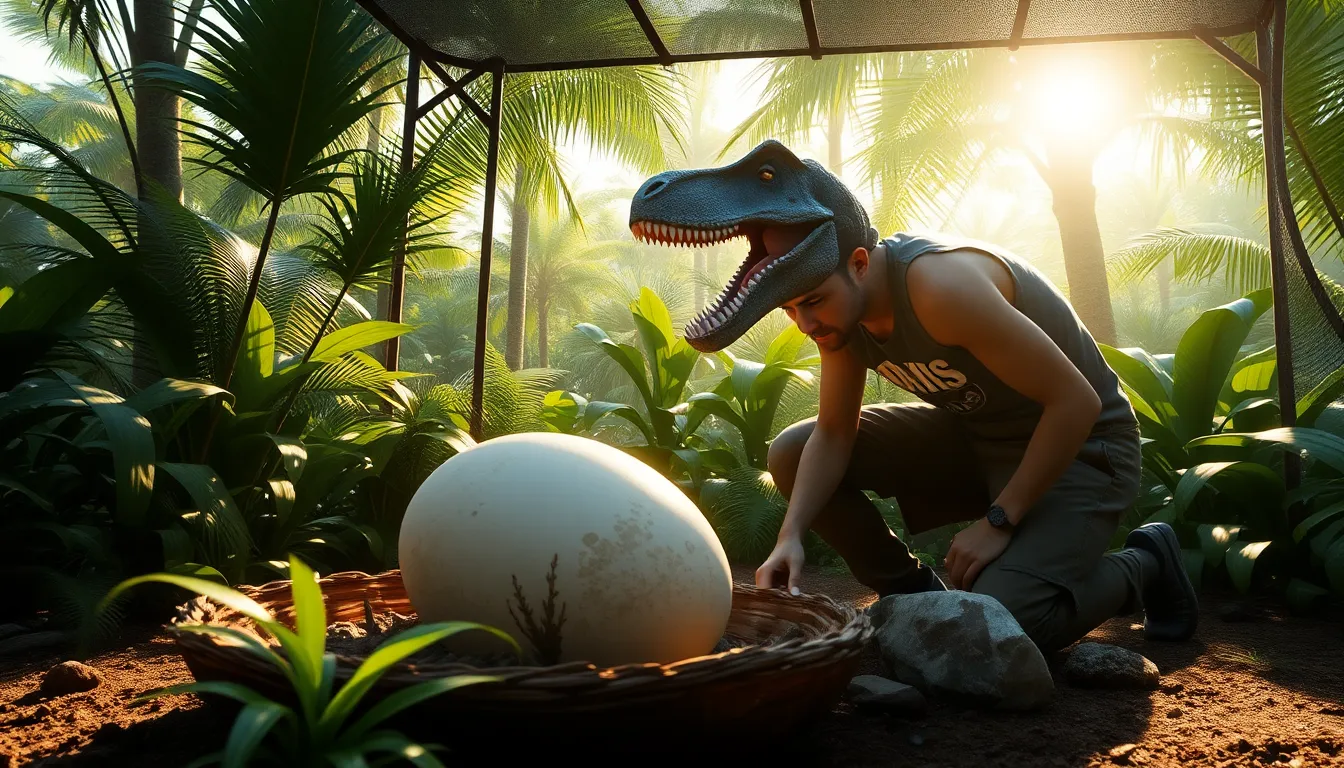In the wild world of Ark, hatching eggs isn’t just a casual pastime; it’s a thrilling adventure that can lead to the most majestic creatures roaming the land. Picture this: you’re sitting on a pile of dino eggs, eagerly waiting for the moment when those little critters break free. It’s like waiting for your toast to pop up—except instead of breakfast, you get a fierce T-Rex or a cuddly Pteranodon.
Table of Contents
ToggleOverview of Ark Egg Hatching
Egg hatching in Ark presents a unique gameplay element. Players often invest time in collecting eggs from various creatures. Each egg type varies in its incubation requirements, influencing the hatching process.
Incubation temperature plays a crucial role. A temperature range between 75°F and 80°F is ideal for most eggs. Too much heat or cold can lead to failure, resulting in the egg being lost.
Time limits also matter. Most eggs take about 1 to 2 hours to hatch in optimal conditions. Players must manage the environment, ensuring the egg remains warm while avoiding overheating.
Players benefit from using incubators. Incubators provide a controlled temperature, speeding up the incubation process. They ensure consistent settings while allowing players to focus on other tasks.
Monitoring the egg’s progress is essential. Players can gauge the hatching reward by observing the egg’s development stages. As the egg nears hatching, it shows visible cues like cracking.
Timing and preparation matter in this exciting endeavor. Ready players should gather essential resources like food and shelter beforehand. New creatures require care and attention immediately after hatching, highlighting the need for planning.
Various creature types produce different egg variants. From the smaller Compy eggs to the vast Rex eggs, variety enriches the hatching experience. Each has its unique challenges and rewards, adding depth to the gameplay.
Each hatching results in a new companion with growth potential. Developing these creatures requires effort and dedication, enhancing the player’s journey through Ark’s dynamic world.
Types of Eggs in Ark

Different types of eggs exist in Ark, each contributing uniquely to the gameplay experience. Understanding their characteristics enhances the hatching adventure.
Fertilized Eggs
Fertilized eggs emerge from mating pairs of creatures, ensuring the potential for offspring. These eggs contain the genetic traits of both parents, leading to diverse and unique creatures. Players must incubate fertilized eggs in proper conditions, maintaining temperatures between 75°F and 80°F. Monitoring the egg’s progress helps determine the imminent hatching. After about 1 to 2 hours, players witness the exciting moment when a new companion breaks free. Caring for these hatchlings immediately after is crucial for their survival and growth. Players can breed and raise these offspring, creating a lineage that can thrive in the world of Ark.
Unfertilized Eggs
Unfertilized eggs do not result in offspring, yet they still hold value. Creatures such as dinosaurs lay these eggs, often used in crafting or cooking recipes. Players can find them scattered throughout the environment, often requiring collection from nests. Managing inventory space becomes essential when gathering unfertilized eggs. Although they do not contribute to creature breeding, players can use them in various recipes that provide beneficial effects. Additionally, players can display them or sell them for resources, making unfertilized eggs valuable in different contexts.
Hatching Process
The hatching process in Ark requires careful attention to detail. Players must understand the specific incubations requirements for each type of egg.
Incubation Requirements
Fertilized eggs need optimal conditions to hatch. Players notice that each egg type, such as Rex or Pteranodon, has unique requirements. Under ideal conditions, eggs typically take 1 to 2 hours to hatch. Proper monitoring during this period ensures players can provide immediate care once offspring emerge. Environmental factors play a crucial role, as providing the right conditions enhances survival rates.
Temperature and Environmental Factors
Maintaining the right temperature is vital for successful hatching. The optimal range for incubation sits between 75°F and 80°F. It’s crucial to avoid temperatures outside this range, as it can lead to egg loss. Environmental factors, including humidity and proximity to heat sources, also affect incubation efficiency. Players can utilize incubators to keep temperatures stable, allowing them to focus on other tasks. Observing the egg frequently for signs of impending hatching enhances the experience.
Care for Hatchlings
After a successful hatching, players must provide immediate care for their new creatures. This involves ensuring that hatchlings receive the proper food and resources.
Food and Resources
Hatchlings require specific food types to thrive. Players should gather appropriate nourishment, such as raw meat for carnivores and berries for herbivores. Throughout their early growth stages, they may consume more resources than expected. Monitoring their food intake regularly helps avoid starvation. Furthermore, players can use feeding troughs to streamline the feeding process. These troughs automatically distribute food, keeping hatchlings fed while allowing players to focus on other activities. Freshly hatched companions rapidly grow, so providing enough food is crucial to their development.
Protecting Hatchlings from Threats
Hatchlings face various threats in Ark’s dynamic environment. Other players, wild creatures, and environmental hazards can endanger newly hatched companions. Players should create a secure area to protect hatchlings from aggressive animals. Building enclosures or placing them near strong allies provides security. It’s important to maintain vigilance during early growth phases when they are more vulnerable. Using a character’s whistle commands can help manage nearby creatures. Engaging threats proactively ensures hatchlings can grow without unnecessary danger. Safety measures significantly enhance the chances of survival for new additions to the player’s team.
Common Challenges in Egg Hatching
Egg hatching in Ark presents various challenges that players must navigate to enjoy a successful experience. Proper understanding of these obstacles enhances the overall success in hatching.
Handling Temperature Fluctuations
Temperature management plays a crucial role in egg hatching. Maintaining a steady temperature between 75°F and 80°F is essential for successful incubation. Fluctuations can occur due to environmental changes or disruptions in the incubator’s functionality. Players need to monitor conditions closely, as even minor deviations can affect hatch timing. Frequent checks can indicate whether adjustments are necessary. Utilizing incubators benefits players by providing stable temperatures, countering issues from external factors. Those who prepare by having backup heat sources can manage unexpected temperature drops effectively. Proper care leads to improved chances of hatching a new companion.
Dealing with Unsuccessful Hatches
Unsuccessful hatches can be disappointing for players. Observing the egg’s incubation period provides insight into potential problems. If an egg fails to hatch after 1 to 2 hours, players need to evaluate various factors. Poor environmental conditions often contribute to hiccups in the hatching process. Inspecting the egg’s appearance can reveal signs of improper incubation. Considering alternatives like adjusting temperature or utilizing a different incubator may enhance success rates. While unfertilized eggs do not hatch, they still hold value for crafting or resources. Players can utilize gathered knowledge to improve future hatching attempts, ensuring a more rewarding experience in Ark.
Hatching eggs in Ark offers an exhilarating blend of strategy and excitement. Players invest time and effort to create optimal conditions for their eggs, eagerly anticipating the moment new creatures emerge. Each successful hatch not only introduces a new companion but also enriches the gameplay experience.
Understanding the nuances of incubation and providing immediate care for hatchlings are essential for nurturing these new allies. With proper attention to detail and strategic planning, players can transform their egg-hatching adventures into rewarding journeys. Embracing the challenges and triumphs of this process ultimately enhances the dynamic world of Ark, making it an unforgettable experience for every player.





